1990 VOLKSWAGEN TRANSPORTER page 54
[x] Cancel search: page 54Page 61 of 165

Downloaded from www.Manualslib.com manuals search engine
I
CONTROLS AND EQUIPMENT
AUXILIARY HEATER* (Syncro models only)
The auxiliary heater* heats the coolant in the heating circuit and supplies the heat exchanger in the normal heating system
and the additional heat exchanger* for the
passenger compartment heating with heated coolant.
The system is switched off and on or the
switch-
on time preselected by means of a
switch and indicator unit located on the left under the instrument panel.
Air distribution and regulation is done with the controls of the normal heating and
ven
tilation system (see "Ventilation/Heating"
on page 51).
The auxiliary heater can be used with vehicle stationary or when it is moving.
When vehicle is stationary, the heater only runs for a maximum of 30 minutes in order
to avoid draining the battery. It also switches off automatically when a coolant
temperature of 80° C (175° F) is reached.
When the coolant temperature drops below 70° C (158° F) the heater is automatically switched on again. The heater runs on fuel from the vehicle
tank and uses up to half a litre (one quart) per hour. Controls
A - Buttons for setting time and
preselected time
B - Indicator lamp for preselected time
C - Preselected time D - Display
E - Actual time
F - Heater on/off
G - Warning lamp (Heater on)
60 "where applicable
www.westfaliaT3.info - a useful website for owners and enthusiasts of VW Westfalia T25 / T3 Campervans
Page 63 of 165
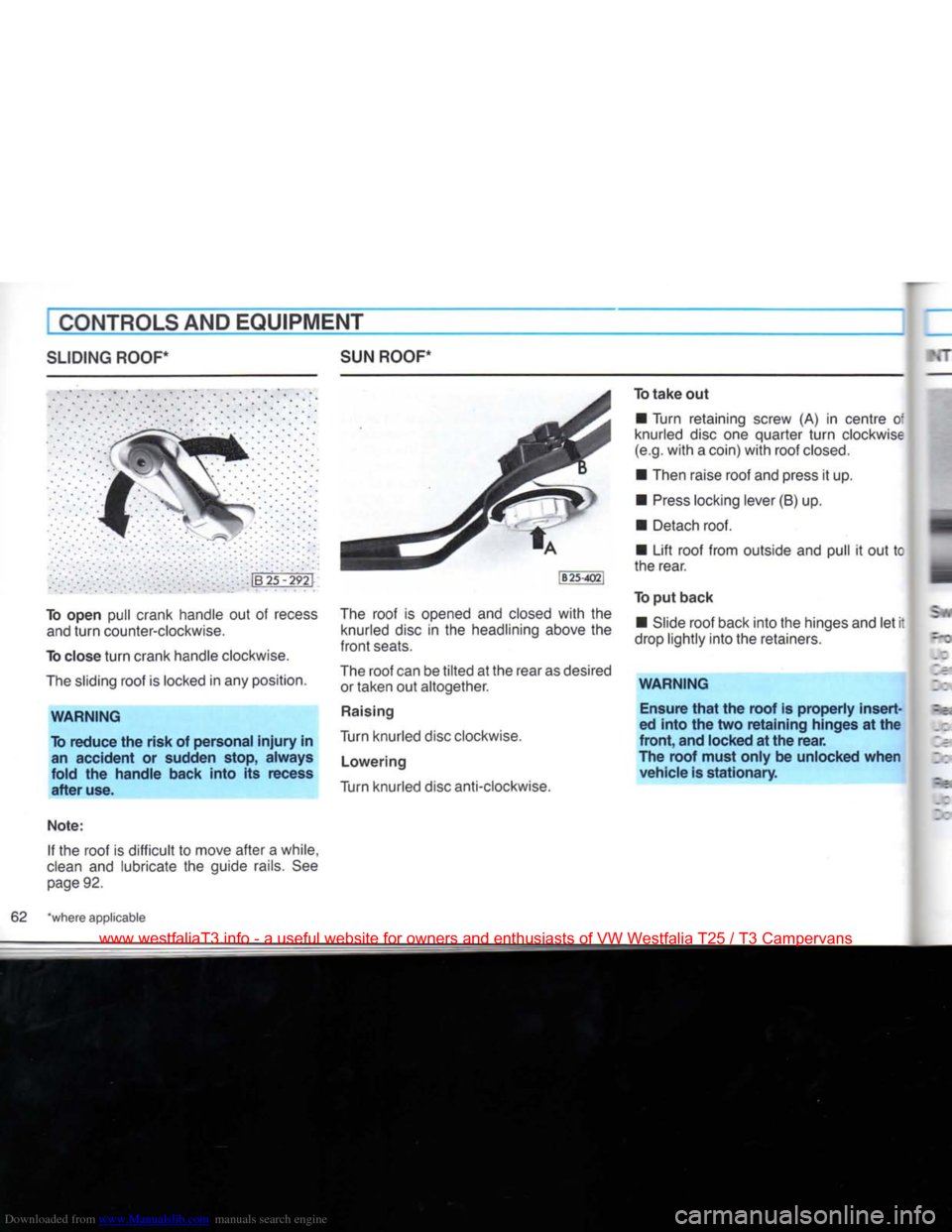
Downloaded from www.Manualslib.com manuals search engine
CONTROLS AND EQUIPMENT
SLIDING
ROOF*
SUN
ROOF*
To open pull crank handle out of recess
and
turn
counter-clockwise.
To close
turn
crank handle clockwise.
The
sliding roof is locked in any position.
WARNING
To
reduce
the
risk
of personal
injury
in an
accident
or sudden stop,
always
fold
the
handle
back
into
its recess
after
use.
Note:
If the roof is difficult to move after a while,
clean
and lubricate the guide rails. See
page
92.
The
roof is opened and closed
with
the
knurled disc in the headlining above the
front
seats.
The
roof can be
tilted
at the rear as desired or taken out altogether.
Raising
Turn knurled disc clockwise.
Lowering
Turn knurled disc anti-clockwise. To
take
out
• Turn retaining screw (A) in centre of
knurled disc one quarter
turn
clockwise
(e.g.
with
a coin)
with
roof
closed.
• Then raise roof and press it up.
•
Press
locking lever (B) up. • Detach roof.
• Lift roof from outside and pull it out tc
the rear.
To put
back
• Slide roof back into the hinges and let it
drop lightly into the retainers.
WARNING
Ensure
that
the
roof
is
properly
insert
ed
into
the two
retaining
hinges at the
front,
and locked at the
rear.
The
roof
must
only
be unlocked
when
vehicle
is
stationary.
62 "where applicable
www.westfaliaT3.info - a useful website for owners and enthusiasts of VW Westfalia T25 / T3 Campervans
Page 69 of 165
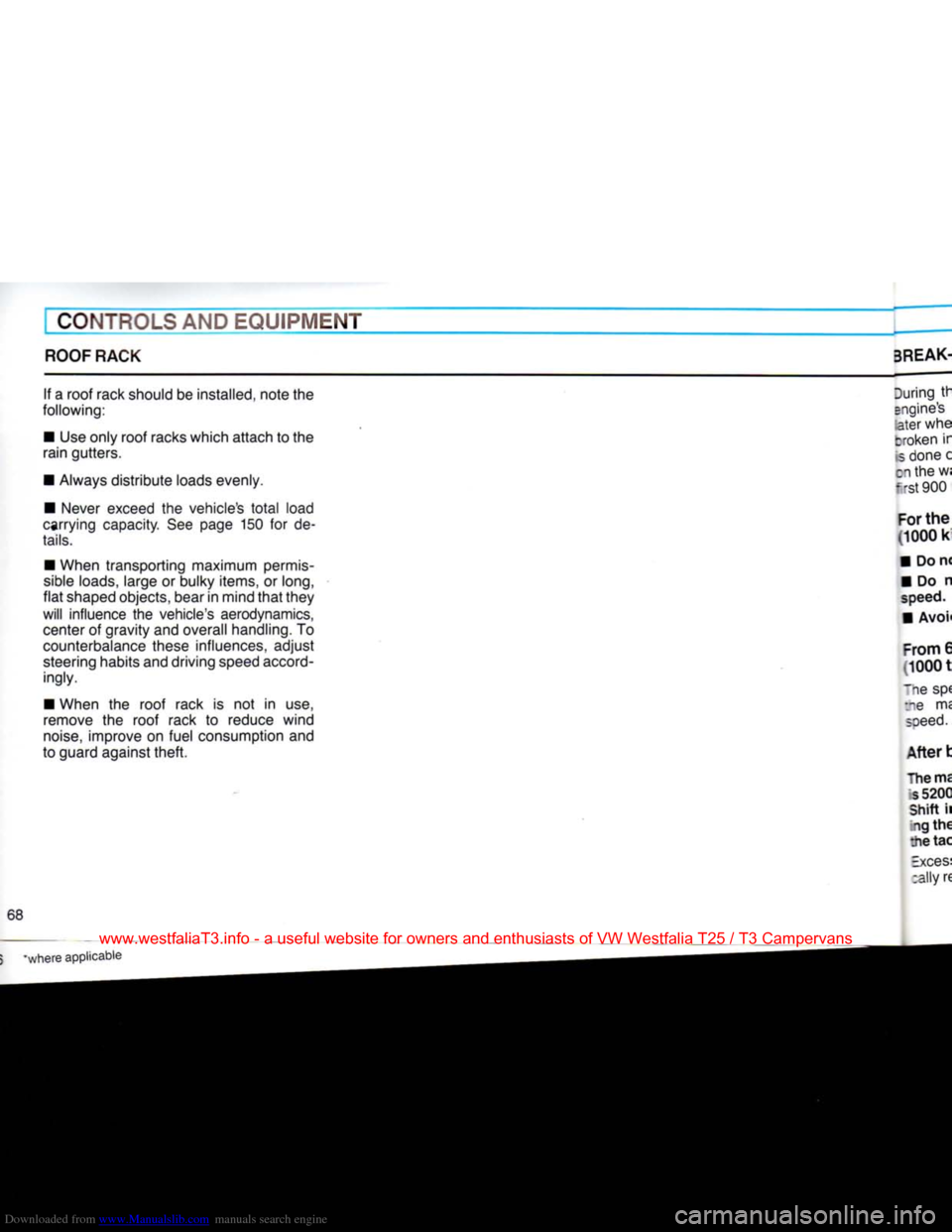
Downloaded from www.Manualslib.com manuals search engine
CONTROLS
AND
EQUIPMENT
ROOF RACK 3REAK-
If a roof rack should be installed, note the
following:
• Use only roof racks which attach to the
rain gutters.
• Always distribute loads evenly.
• Never exceed the vehicle's
total
load
carrying capacity. See page 150 for de
tails.
• When transporting maximum permis
sible
loads, large or bulky items, or long,
flat
shaped objects, bear in mind
that
they
will
influence the vehicle's aerodynamics,
center of gravity and overall handling. To
counterbalance these influences, adjust steering habits and driving speed accord
ingly.
• When the roof rack is not in use,
remove the roof rack to reduce wind
noise,
improve on fuel consumption and
to guard against
theft.
68
www.westfaliaT3.info - a useful website for owners and enthusiasts of VW Westfalia T25 / T3 Campervans
Page 70 of 165
![VOLKSWAGEN TRANSPORTER 1990 T4 / 4.G Owners Manual Downloaded from www.Manualslib.com manuals search engine
3REAK-IN
PERIOD
VEHICLE
OPERATION]
DURING AND
AFTER
BREAK-IN PERIOD
Turing
the first few operating
hours,
the
r-gines
internal VOLKSWAGEN TRANSPORTER 1990 T4 / 4.G Owners Manual Downloaded from www.Manualslib.com manuals search engine
3REAK-IN
PERIOD
VEHICLE
OPERATION]
DURING AND
AFTER
BREAK-IN PERIOD
Turing
the first few operating
hours,
the
r-gines
internal](/manual-img/18/7415/w960_7415-69.png)
Downloaded from www.Manualslib.com manuals search engine
3REAK-IN
PERIOD
VEHICLE
OPERATION]
DURING AND
AFTER
BREAK-IN PERIOD
Turing
the first few operating
hours,
the
r-gine's
internal friction is higher than
a:er
when all the moving parts
have
been
:-oken
in. How well this break-in
process
e
done
depends
to a
considerable
extent
:n
the way the
vehicle
is driven during the
-"-3t
900
miles
(1500 kilometers).
For
the first 600 miles
(1000 kilometers):
•
Do not use full
throttle.
•
Do not drive faster
than
3A of top
speed.
•
Avoid high engine speeds.
From
600 to 900 miles
(1000 to 1500 kilometers):
The
speed
can gradually be
increased
to
:he
maximum road
speed
or
engine
speed.
After break-in period
The maximum permissible engine speed
is
5200
rpm and should not be exceeded.
Shift into the higher gear before reaching the red area at the end of the scale of
the tachometer. See page 41.
Excessive
engine
speeds
are automati
cally
reduced.
•
Details
on how to operate the
Manual
and
Automatic
transmission
are outlined
in
the
"Controls
and
equipment"
chapter.
•
Avoid full
throttle
starts and abrupt
stops.
•
Try to avoid running the engine at
maximum speed. Shifting up early helps
to save fuel and reduces noise.
•
Do not overstrain engine; select pro
per gear before reaching top speeds.
•
Do not let engine labor. Shift down
when engine no longer runs smoothly.
•
All
revs
are only
valid
when
engine
is
properly
warm.
•
Always
observe
local
and national
speed
limits.
Applies
in addition to vehicles
with
Automatic
Transmission:
Make
it a habit to
accelerate
gradually
instead
of
using
full throttle. During
gra
dual
acceleration
the
transmission
shifts
earlier
into the next higher
gear
thus
saving
fuel.
WARNING
•
New tires do not
possess
maximum
traction. They tend to be slippery. Break new tires in by driving cautiously
at moderate speed for the first 100 miles (160 kilometers).
•
New brake pads and linings do not
have optimum friction properties and
must be "broken in" during the
initial
100 to 150 miles (150 to 200 kilometers)
of normal city driving. You can compen sate for this by applying more pressure
on
the brake pedal. This also applies
later
when new pads or linings are
installed.
www.westfaliaT3.info - a useful website for owners and enthusiasts of VW Westfalia T25 / T3 Campervans
Page 73 of 165
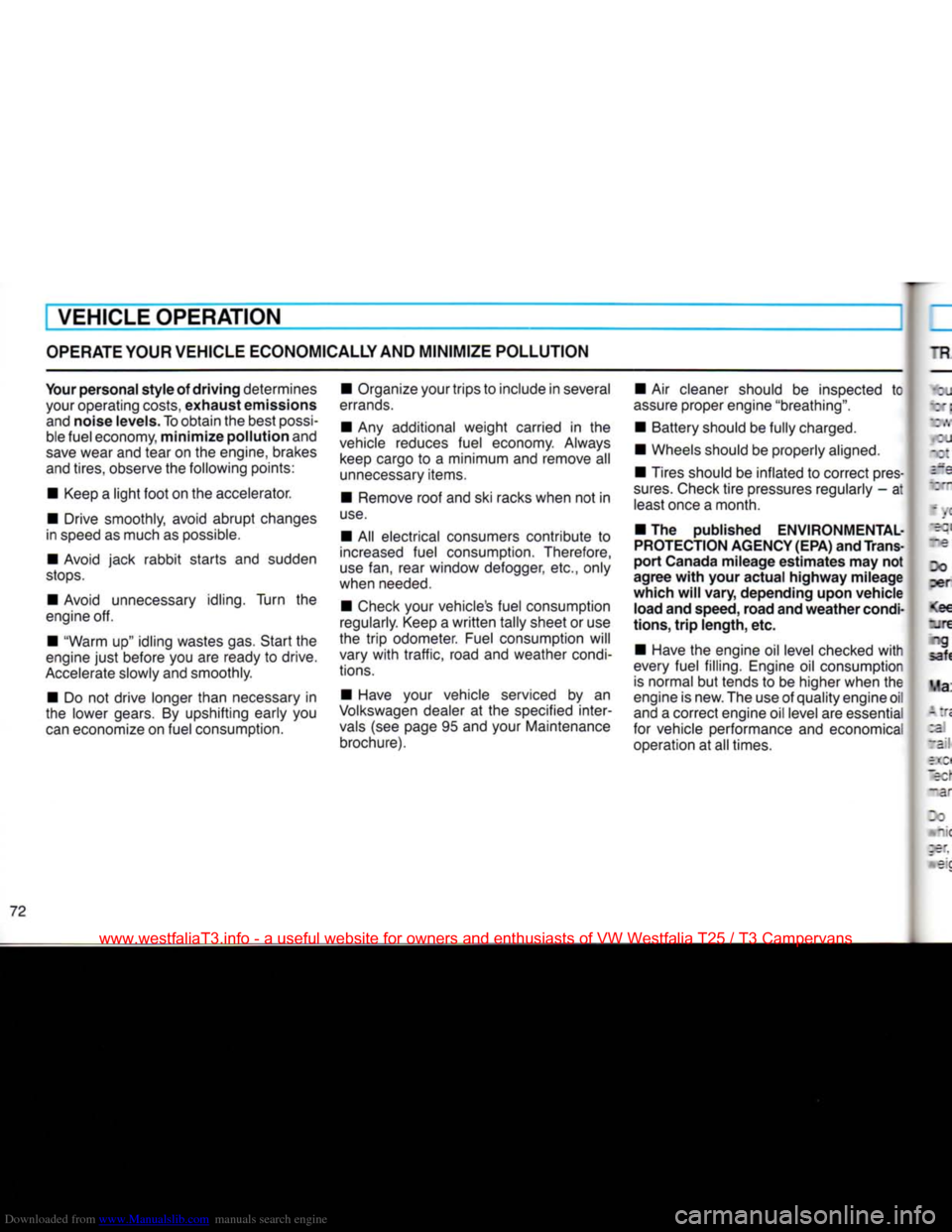
Downloaded from www.Manualslib.com manuals search engine
VEHICLE OPERATION
OPERATE
YOUR VEHICLE ECONOMICALLY AND
MINIMIZE
POLLUTION
Your
personal
style
of
driving
determines your operating costs,
exhaust
emissions and noise levels. To obtain the best
possi
ble fuel economy,
minimize
pollution
and
save
wear and tear on the engine, brakes
and tires, observe the following points:
• Keep a
light
foot
on the accelerator.
• Drive smoothly, avoid abrupt changes
in speed as much as possible.
• Avoid jack rabbit starts and sudden
stops.
• Avoid unnecessary idling. Turn the
engine off.
• "Warm up" idling wastes gas. Start the
engine
just
before you are ready to drive.
Accelerate
slowly and smoothly.
• Do not drive longer than necessary in
the lower gears. By upshifting early you
can
economize on fuel consumption. • Organize your trips to include in several
errands.
• Any additional weight carried in the
vehicle reduces fuel economy. Always keep cargo to a minimum and remove all
unnecessary
items.
• Remove roof and ski racks when not in
use.
• All electrical consumers contribute to
increased
fuel consumption. Therefore,
use
fan, rear window defogger, etc., only
when needed.
• Check your vehicle's fuel consumption
regularly. Keep a
written
tally sheet or use
the
trip
odometer. Fuel consumption will
vary
with
traffic, road and weather condi
tions.
• Have your vehicle serviced by an
Volkswagen
dealer at the specified inter
vals
(see page 95 and your Maintenance brochure). • Air cleaner should be inspected to
assure
proper engine "breathing".
• Battery should be fully charged.
• Wheels should be properly aligned.
• Tires should be inflated to correct pres
sures.
Check
tire
pressures regularly - at least once a month.
• The published ENVIRONMENTAL-
PROTECTION AGENCY (EPA) and Trans
port
Canada
mileage
estimates
may not
agree
with
your
actual
highway
mileage
which
will
vary,
depending
upon
vehicle
load
and speed,
road
and
weather
condi
tions,
trip
length,
etc.
• Have the engine oil level checked
with
every fuel filling. Engine oil consumption
is
normal but tends to be higher when the
engine is new. The use of quality engine oil
and a correct engine oil level are essential
for vehicle performance and economical operation at all times.
72
www.westfaliaT3.info - a useful website for owners and enthusiasts of VW Westfalia T25 / T3 Campervans
Page 79 of 165
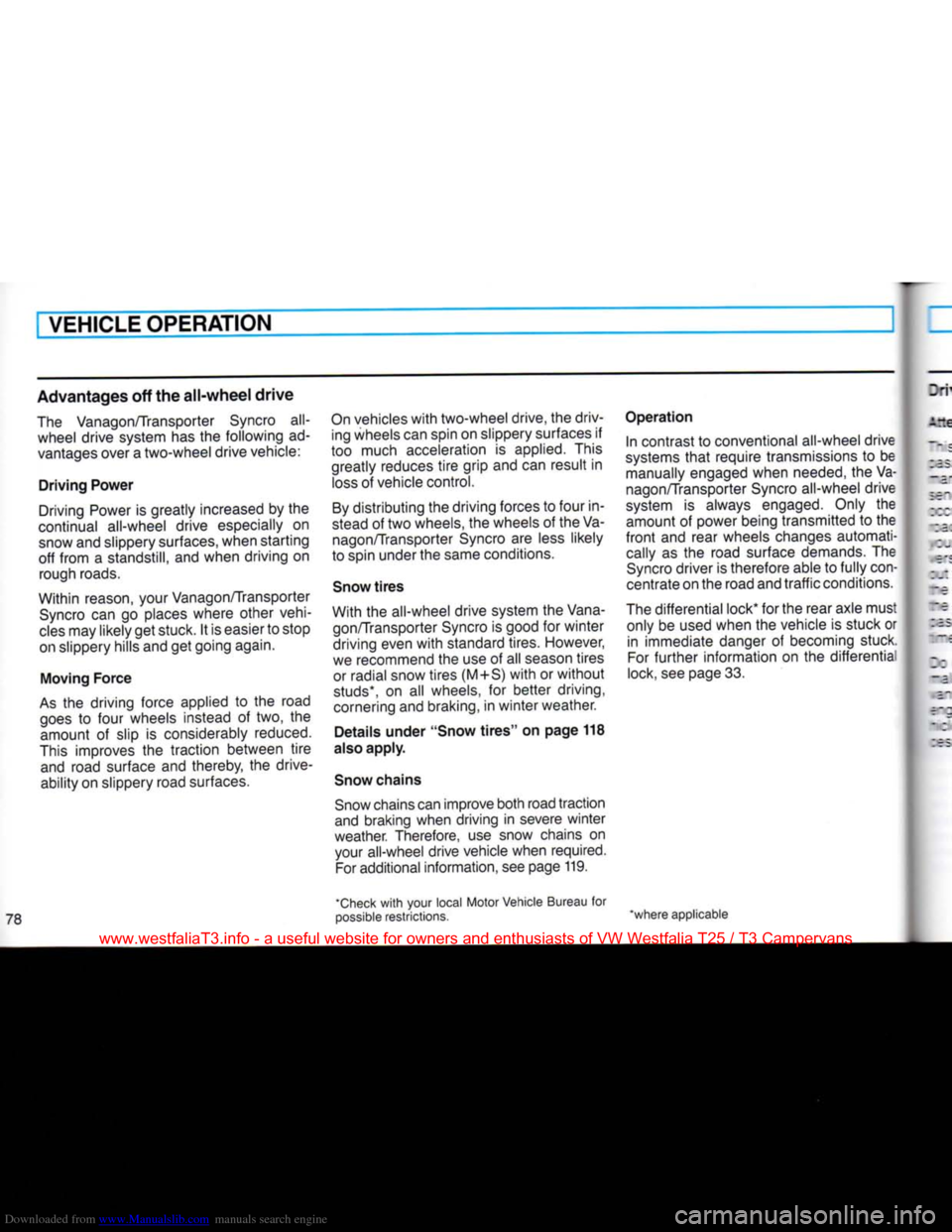
Downloaded from www.Manualslib.com manuals search engine
VEHICLE OPERATION
Advantages off the all-wheel drive
The Vanagon/Transporter Syncro
all-
wheel drive system
has the
following
ad
vantages over
a
two-wheel drive vehicle:
Driving Power
Driving Power
is
greatly increased
by the
continual all-wheel drive especially
on
snow
and
slippery surfaces, when starting
off from
a
standstill,
and
when driving
on
rough roads.
Within reason, your Vanagon/Transporter Syncro
can go
places where other
vehi
cles
may
likely
get
stuck.
It is
easier
to
stop
on slippery hills
and get
going again.
Moving Force
As
the
driving force applied
to the
road goes
to
four wheels instead
of two, the
amount
of
slip
is
considerably reduced.
This improves
the
traction between tire and road surface
and
thereby,
the
drive-
ability
on
slippery road surfaces. On vehicles with two-wheel drive,
the
driv
ing wheels
can
spin
on
slippery surfaces
if
too much acceleration
is
applied. This
greatly reduces tire grip
and can
result
in
loss
of
vehicle control.
By distributing
the
driving forces
to
four
in
stead
of two
wheels,
the
wheels
of the
Va nagon/Transporter Syncro
are
less likely
to spin under
the
same conditions.
Snow tires
With
the
all-wheel drive system
the
Vana gon/Transporter Syncro
is
good
for
winter
driving even with standard tires. However,
we recommend
the use of all
season tires
or radial snow tires (M
+
S) with
or
without
studs*,
on all
wheels,
for
better driving,
cornering
and
braking,
in
winter weather.
Details under "Snow tires"
on
page
118
also apply.
Snow chains
Snow chains can improve both road traction
and braking when driving
in
severe winter
weather. Therefore,
use
snow chains
on
your all-wheel drive vehicle when required. For additional information,
see
page
119.
Operation
In contrast
to
conventional all-wheel drive
systems that require transmissions
to be
manually engaged when needed,
the Va
nagon/Transporter Syncro all-wheel drive
system
is
always engaged. Only
the
amount
of
power being transmitted
to the
front
and
rear wheels changes automati cally
as the
road surface demands.
The
Syncro driver
is
therefore able
to
fully
con
centrate
on the
road and traffic conditions.
The differential lock*
for the
rear axle must only
be
used when
the
vehicle
is
stuck
or
in immediate danger
of
becoming stuck. For further information
on the
differential
lock,
see
page
33.
78 "Check with your local Motor Vehicle Bureau
for
possible restrictions.
'where applicable
www.westfaliaT3.info - a useful website for owners and enthusiasts of VW Westfalia T25 / T3 Campervans
Page 80 of 165
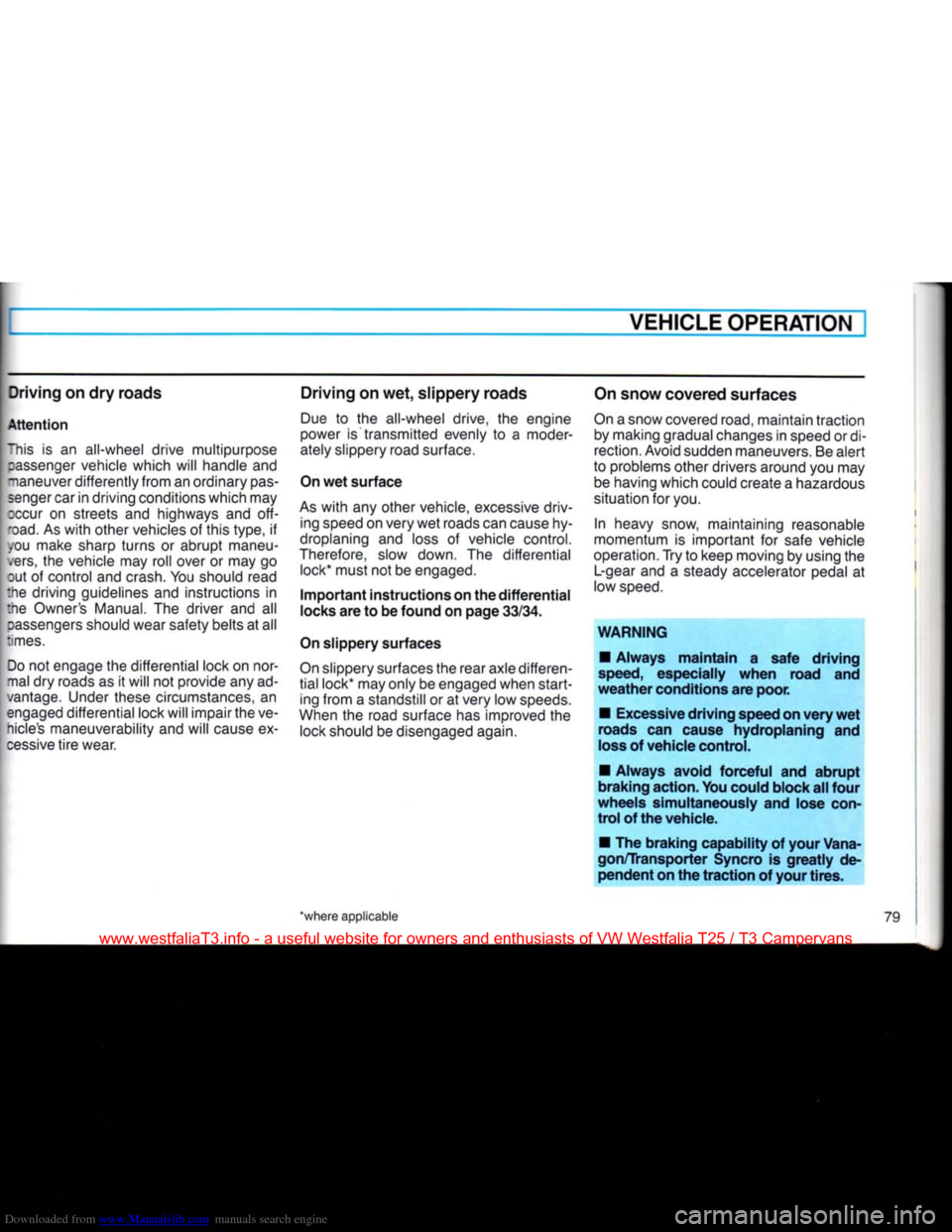
Downloaded from www.Manualslib.com manuals search engine
-
VEHICLE
OPERATION
Driving on dry roads
Attention
"his
is an
all-wheel drive multipurpose
rassenger
vehicle which
will
handle
and
maneuver
differently
from
an ordinary
pas
senger
car in driving conditions which may
occur
on
streets
and
highways
and off-
'oad.
As
with
other vehicles
of
this type,
if
you make sharp turns
or
abrupt maneu
vers,
the
vehicle
may
roll over
or
may
go
kit
of
control and
crash.
You should read
:he driving guidelines
and
instructions
in
the Owner's
Manual.
The
driver
and all
oassengers
should wear safety belts
at all
times.
Do
not
engage
the
differential lock on nor
mal
dry
roads
as it
will
not
provide any ad
vantage. Under these circumstances,
an
engaged differential lock
will
impair the ve-
nicle's
maneuverability and
will
cause
ex
cessive
tire
wear.
Driving on wet, slippery roads
Due
to the
all-wheel drive,
the
engine
power
is
transmitted evenly
to a
moder
ately slippery road surface.
On
wet surface
As
with
any
other vehicle, excessive driv ing speed on very wet roads can cause hy
droplaning
and
loss
of
vehicle control.
Therefore, slow down.
The
differential lock* must
not be
engaged.
Important
instructions
on
the
differential
locks
are to be found on page
33/34.
On
slippery surfaces
On
slippery surfaces the rear axle differen
tial
lock may only be engaged when
start
ing
from
a
standstill
or at
very low
speeds.
When
the
road surface has improved
the
lock should
be
disengaged again. On
snow covered surfaces
On
a
snow covered road, maintain traction by making gradual changes
in
speed
or
di
rection. Avoid sudden maneuvers. Be alert
to problems other drivers around you may be having which could create
a
hazardous
situation
for
you.
In heavy snow, maintaining reasonable
momentum
is
important
for
safe vehicle
operation. Try
to
keep moving
by
using
the
L-gear and
a
steady accelerator pedal
at
low
speed.
WARNING
•
Always
maintain
a safe driving
speed,
especially
when
road and
weather
conditions are poor.
•
Excessive
driving speed on very wet
roads can cause hydroplaning and
loss
of vehicle control.
•
Always avoid forceful and
abrupt
braking action.
You
could block all four
wheels simultaneously and lose
con
trol
of the vehicle.
•
The braking capability of your Vana-
gon/Transporter Syncro is
greatly
de
pendent on the
traction
of your tires.
'where applicable 79
www.westfaliaT3.info - a useful website for owners and enthusiasts of VW Westfalia T25 / T3 Campervans
Page 81 of 165
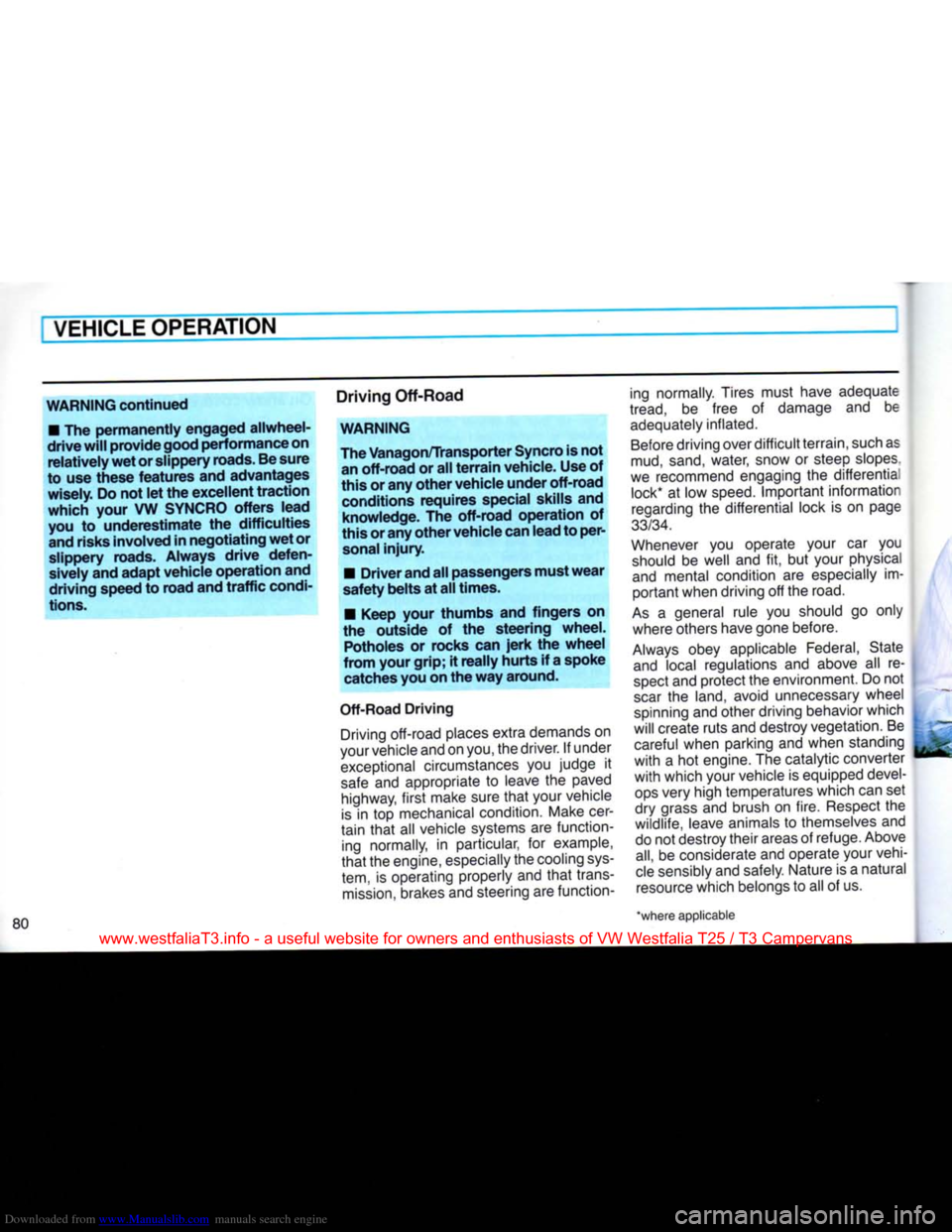
Downloaded from www.Manualslib.com manuals search engine
VEHICLE
OPERATION
WARNING continued
•
The permanently engaged allwheel-
drive
will
provide
good
performance on relatively wet or slippery
roads.
Be
sure
to use these features and advantages
wisely. Do not let the excellent traction
which your VW
SYNCRO
offers lead
you
to underestimate the difficulties
and risks involved in negotiating wet or
slippery
roads. Always drive defen
sively
and adapt vehicle operation and
driving speed to road and
traffic
condi
tions.
Driving Off-Road
WARNING
The Vanagon/Transporter
Syncro
is not an off-road or all
terrain
vehicle. Use of
this or any other vehicle under off-road
conditions
requires special skills and knowledge. The off-road operation of
this or any other
vehicle
can
lead
to per
sonal
injury.
•
Driver and all
passengers
must
wear
safety belts at all times.
•
Keep your thumbs and fingers on
the outside of the steering wheel.
Potholes
or rocks can
jerk
the
wheel
from your grip; it really hurts if a spoke
catches
you on the way around.
Off-Road
Driving
Driving off-road places extra demands
on
your vehicle and on you, the driver.
If
under
exceptional
circumstances
you
judge
it
safe
and
appropriate
to
leave
the
paved highway,
first
make sure
that
your vehicle
is
in top
mechanical condition. Make cer
tain
that
all
vehicle systems
are
function ing normally,
in
particular,
for
example,
that
the engine, especially the cooling
sys
tem,
is
operating properly and
that
trans
mission,
brakes and steering are function ing normally. Tires must have adequate
tread,
be
free
of
damage
and be
adequately inflated.
Before
driving over
difficult
terrain, such as
mud,
sand,
water, snow
or
steep
slopes,
we recommend engaging
the
differentia lock*
at low
speed.
Important
information
regarding
the
differential lock
is on
page
33/34.
Whenever
you
operate your
car you
should
be
well
and fit, but
your physical
and
mental condition
are
especially
im
portant
when driving
off
the road.
As
a
general rule
you
should
go
only where others have gone before.
Always
obey applicable
Federal,
State
and
local regulations
and
above
all re
spect
and protect the environment. Do
not
scar
the
land, avoid unnecessary wheel
spinning and other driving behavior which
will
create
ruts
and destroy vegetation.
Be
careful when parking and when standing
with
a hot
engine. The catalytic converter
with
which your vehicle
is
equipped devel
ops
very high temperatures which can set
dry grass and brush
on
fire. Respect
the
wildlife, leave animals
to
themselves
and
do not destroy their areas
of
refuge. Above
all,
be
considerate and operate your vehi
cle
sensibly and safely. Nature
is a
natural
resource
which belongs
to
all
of
us.
'where applicable
www.westfaliaT3.info - a useful website for owners and enthusiasts of VW Westfalia T25 / T3 Campervans